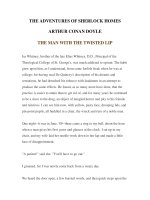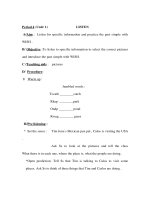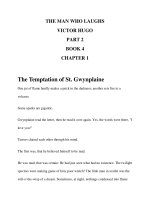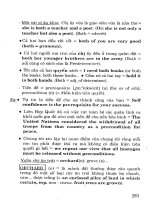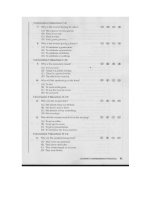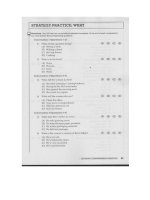4 6 1 we shall overcome
Bạn đang xem bản rút gọn của tài liệu. Xem và tải ngay bản đầy đủ của tài liệu tại đây (4 MB, 12 trang )
Suggested levels for Guided Reading, DRA,™
Lexile,® and Reading Recovery™ are provided
in the Pearson Scott Foresman Leveling Guide.
We Shall
Overcome
by Chanelle Peters
Genre
Expository
nonfiction
Comprehension
Skills and Strategy
• Cause and Effect
• Sequence
• Answer Questions
Text Features
• Labels
• Captions
• Glossary
Scott Foresman Reading Street 4.6.1
ISBN 0-328-13487-2
ì<(sk$m)=bdeihi< +^-Ä-U-Ä-U
Reader Response
We Shall
Overcome
1. Use a chart like the one below to tell at least two
causes and effects in the journey to freedom for
enslaved people.
Cause
by Chanelle
Peters escaped
Harriet Tubman
Effect
to freedom.
2. Why did Isabella Baumfree change her name to
Sojourner Truth? What other questions do you
have about Sojourner Truth? Where could you go
to find answers?
3. What other words have the same base word as
avoided?
4. Using the pictures and labels, name the famous
women pictured in this book.
Editorial Offices: Glenview, Illinois • Parsippany, New Jersey • New York, New York
Sales Offices: Needham, Massachusetts • Duluth, Georgia • Glenview, Illinois
Coppell, Texas • Ontario, California • Mesa, Arizona
A Fight for Freedom
For hundreds of years, generations of African
Americans have struggled to be treated as equals in
the United States. Many were forced to come to the
United States as enslaved people. Over time, many
Americans saw this was wrong and fought hard to end
slavery. Even after slavery was over, though, the fight
for equality continued.
The first Africans brought to the United States had
been captured and taken from their homelands in
Africa. They came to the United States by boat. Once
in the United States, most Africans were sold and
forced to work on large farms called plantations.
Enslaved people from Africa
work on a plantation.
Every effort has been made to secure permission and provide appropriate credit for
photographic material. The publisher deeply regrets any omission and pledges to
correct errors called to its attention in subsequent editions.
Unless otherwise acknowledged, all photographs are the property of Scott Foresman,
a division of Pearson Education.
Photo locators denoted as follows: Top (T), Center (C), Bottom (B), Left (L), Right (R),
Background (Bkgd)
Opener: MPI/Getty Images; 1 Library of Congress; 3 Library of Congress; 4 Library of
Congress; 5 Library of Congress; 7 (TL, BR) Library of Congress; 8 Library of Congress;
10 Library of Congress; 11 Library of Congress; 12 Library of Congress; 14 Library of
Congress; 16 MPI/Getty Images; 17 Library of Congress; 18 Flip Schulke/Corbis; 19 Flip
Schulke/Corbis
ISBN: 0-328-13487-2
Copyright © Pearson Education, Inc.
All Rights Reserved. Printed in the United States of America. This publication is
protected by Copyright, and permission should be obtained from the publisher
prior to any prohibited reproduction, storage in a retrieval system, or transmission
in any form by any means, electronic, mechanical, photocopying, recording, or
likewise. For information regarding permission(s), write to: Permissions Department,
Scott Foresman, 1900 East Lake Avenue, Glenview, Illinois 60025.
2 3 4 5 6 7 8 9 10 V0G1 14 13 12 11 10 09 08 07 06 05
3
The captured Africans resisted being enslaved.
Some Africans would fight members of the ship’s crew
on the way to the United States. Others would jump
into the ocean. Some Africans would wait until they
were in the United States to fight back. Some ran away
from the plantation owners. Others pretended to
be sick. Some simply refused to work. Sadly, it
was going to take a much larger effort to put an
end to slavery in the United States.
In the early 1800s numerous African
and European Americans joined together
to fight against slavery. Their goal was
to abolish, or end, slavery. They became
known as abolitionists. Many abolitionists
formed groups, held meetings and
conferences, refused to buy products
made by enslaved people, and gave
speeches about ending slavery. However,
the struggle was deeper and more
personal for African Americans. They
wanted to have equal rights in the United
States.
African Americans
wanted their freedom.
4
5
The Abolitionist
Movement
In 1829 a people’s
abolitionist movement
began with the writings
of David Walker. Walker’s
father was an enslaved
man and his mother
was a free African
American woman.
Walker was interested
in the fact that not all
William Lloyd Garrison
African Americans were
enslaved. Walker’s writing
told enslaved people to use force when rebelling, or
fighting back, against their masters.
William Lloyd Garrison was a European American
abolitionist who did not agree with Walker’s idea of
using violence to help end slavery. From 1831 to 1865,
Garrison published a newspaper called The Liberator
and in it asked abolitionists to use nonviolent actions
to change peoples’ minds about slavery.
6
Another abolitionist who believed in nonviolence
was Frederick Douglass. He had been enslaved in
Maryland before escaping to freedom. Douglass spent
most of his life giving speeches about equality and
the end of slavery. Douglass also published a book in
1845 about his life as an enslaved man. It was called
Narrative of the Life of Frederick Douglass, an
American Slave, Written by Himself.
Frederick Douglass
7
Women also played an important role in the
abolitionist movement. They spoke out against slavery
through public speaking and writing. Many women
escaped slavery themselves and went on to help
others escape to freedom.
In 1831 Maria Stewart began writing and making
speeches about ending slavery and making the lives of
African American people better. Stewart was African
American and the first American woman ever to speak
about political issues in public. She strongly believed
in equal rights not just for African Americans but for
all women.
In 1843 Isabella Baumfree was a free woman from
New York who was once enslaved. She believed she
had a duty to speak about ending slavery. Baumfree
also believed that with her new life she had a new
name. She began calling herself Sojourner Truth. Truth
never learned to read because she was born into
slavery and was not allowed to go to school. Still, she
had good speaking skills and gave powerful speeches.
In 1849 an enslaved woman named Harriet Tubman
ran away from her owner in Maryland and escaped to
Pennsylvania. Tubman returned to the South nineteen
times to help other enslaved people get to freedom.
Sojourner Truth
8
9
Harriet Tubman was one of the most well-known
“conductors” of the Underground Railroad. The
Underground Railroad was not a railroad. It involved
a group of people throughout the country. These
people helped enslaved people escape from the South.
They gave them safe places to stay on their journey.
The Underground Railroad used railroad words to
describe itself. The places where runaways would rest
and eat were called stations and depots. They were
run by stationmasters.
People who donated
money and supplies
were stockholders.
The conductors were
in charge of moving
runaways from one
station to the next and
shielding them from
danger on the journey.
Harriet Tubman
10
President Abraham Lincoln signed the
Emancipation Proclamation on January 1, 1863. This
freed some enslaved people. But black people did not
automatically get equal rights in the United States. In
many areas they were not allowed to be in the same
places as white people. Black people were separated
from white people in schools, on buses, and in
restaurants. It was not until the 1950s and 1960s that
black people finally began getting equal treatment,
but it was a struggle. This struggle to gain equal rights
was known as the civil rights movement.
11
Rosa Parks
The Civil Rights Movement
Until the early 1950s black children in some
states were not allowed to attend school with white
children. In 1952 some lawyers went to the U.S.
Supreme Court, the highest court in the nation. They
argued that black children should be able to attend
school with white children. The lawyers said that
separating black students from white students in
schools based on skin color was unjust. They believed
it should not be allowed. The Supreme Court agreed
and made it illegal for black students to be prevented
from going to school with white students.
12
Other changes were taking place in the 1950s.
Black people were only allowed to sit in the back
seats of buses: The front seats were for white people.
In December 1955 a woman named Rosa Parks was
arrested in Montgomery, Alabama, because she would
not give up her seat on a bus to a white person.
When other black people heard about the arrest
of Ms. Parks, they decided to boycott, or stop using,
the buses.Then, in 1956, the U.S. Supreme Court ruled
that separating people on buses was unconstitutional,
against our country’s basic principles.
13
The fight for equal rights continued into the
1960s. Black people were not allowed to eat at lunch
counters or restaurants with white people. In 1960
four black students in North Carolina went into a
store and sat down at the lunch counter. No one
would serve them because they were black. The
students stayed at the lunch counter until closing.
The next day, the students came back. They
brought more students with them for support. Soon
the idea caught on. Students in other cities started
going to lunch counters and refusing to leave, even
though they were never given any food.
The black students were sometimes badly treated
by white people during this time. The students
avoided using violence toward others, though. They
chose to let their actions
speak for themselves. Some
students in North Carolina
even formed their own
group called the Student
Nonviolent Coordinating
Committee, or SNCC.
Black students sitting-in at a
lunch counter in 1960
14
15
Black people finally made the United States see
that they were not going to give up. They wanted
their equal rights. They were not going to be
separated from white people because of the color
of their skin. On August 28, 1963, about 250,000
people, black and white, gathered for the March on
Washington. They marched to the Lincoln Memorial in
Washington, D.C. They came to ask President John F.
Kennedy and Congress to give all people equal rights
to education, jobs, and the use of public places. They
had come together to let their voices be heard.
A young minister
named Reverend Dr.
Martin Luther King, Jr.,
attended the March on
Washington. He was a
long-time leader in the
civil rights movement.
He helped lead the bus
boycott in Montgomery,
Reverend Dr. Martin Luther Alabama. Dr. King was
King, Jr.
a powerful speaker. He
stood before the huge
crowd of marchers in Washington, D.C., just as he
stood at the pulpit of his church. He gave a speech
called “I Have a Dream.” Dr. King spoke of his hope
that one day people of all backgrounds would be
able to treat one another as equals. He believed in
nonviolence, and he spoke with strength. His dream
was the dream of all his supporters who cheered for
him to share his dreams for America’s future.
March on Washington
16
17
Making a Difference
By 1965 the government had passed more laws
that gave people rights in the United States. One of
the most famous of these laws was the Voting Rights
Act of 1965. This act made it illegal for states in the
South to prevent black
people from voting
and letting their voices
be heard on political
decisions. As a result
of the Voting Rights Act
of 1965, the number
of registered black
voters grew. This law
also helped many black
people become a part
of politics and get jobs
in government.
Voting in Alabama
18
During the civil
rights movement,
African American
people were known to
sing a song that many
of their ancestors had
sung during the days
of slavery. Bringing
their voices together
in song helped them
to find strength. The
song was called “We
Shall Overcome.” It was
one of the many ways
that African American
people showed the
United States that they
would hold on until
they were given equal
Integrated voting for the
rights.
first time in a small town
in Alabama
Today there are still
times when people
across the United States struggle to be treated fairly.
But they remember all the people in the past who
refused to be treated differently because of the color
of their skin, and they find the strength to overcome.
19
Glossary
ancestors n. people
from whom you are
descended.
avoided v. kept away
from.
generations n. people
born about the same
time.
minister n. member
of the clergy; spiritual
guide; pastor.
Reader Response
numerous adj. very
many.
pulpit n. the platform
or raised structure in a
church from which the
minister preaches.
1. Use a chart like the one below to tell at least two
causes and effects in the journey to freedom for
enslaved people.
Cause
Harriet Tubman escaped
to freedom.
Effect
shielding v. protecting;
defending.
2. Why did Isabella Baumfree change her name to
Sojourner Truth? What other questions do you
have about Sojourner Truth? Where could you go
to find answers?
3. What other words have the same base word as
avoided?
4. Using the pictures and labels, name the famous
women pictured in this book.
20

